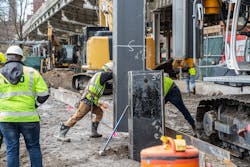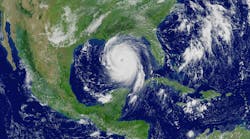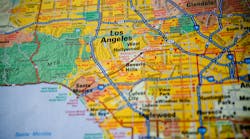New York is no stranger to intense storms.
And following Superstorm Sandy in 2012, several New York departments got to work. About two years after Superstorm Sandy, HUD hosted a competition called Rebuild by Design, which was won by the Bjarke Ingels Group (BIG) with its BIG U project proposal, part of this is the East Side Coastal Resiliency (ESCR).
ESCR sits in one of the low-lying vulnerable areas of Manhattan, Thuloan Dinh, program director at DDC for the coastal resiliency team, which manages this project, said.
Dinh continued by explaining that when Superstorm Sandy happened, coastal flooding ran through East River Park, which is the east-most property at that location went over FDR Drive and then into residential buildings.
“All of Lower Manhattan was really out for months, with just no electricity,” Dinh said. “We got hit really, really hard, and that was, I want to say, the genesis of it all.”
Dinh described the ESCR project as an integrated, coastal protection system that is aimed at addressing coastal flooding.
The project stretches along 2.4 miles – it begins at Montgomery Street and heads north to East 25th Street – and is made of numerous components, including a flood wall with swing and roller gates and an underground sewer management system to address runoff. To tackle the project, the team divided it into three contracts; Project Area 1 (PA1), Project Area 2 (PA2), and Parallel Conveyance (PC).
In short, the parallel conveyance contract is sewer infrastructure. According to the project website, PA1 and PA2 “protect the community from coastal/tidal flooding and saltwater, the PC upgrades will protect the community from floods that result from heavy rainfall during storm events within the neighborhoods.” The PC aspect consists of sewer upgrades, two interceptor gates, two buildings and several manhole excavations.
New York City’s Department of Transportation will maintain and operate the roller and swing gates during a storm event.
“We worked hand-in-hand with DOT to make sure that everyone at the time of a storm event would be able to manage their own pieces of the project,” Dinh said.
While ESCR is part of the BIG U, there are other sections, including the Brooklyn Bridge Montgomery Coastal Resilience (BMCR), Lower Manhattan Coastal Resilience (LMCR), and Battery Park City Resilience Projects.
“These projects just have to be so unique to its actual location,” Dinh said. “There’s no one cookie cutter infrastructure type for each project.”
PA2 started first in November 2020 and includes flood walls, which sewers will have to fit through underground, and swing and roller gates. It is slated to be substantially complete by 2024. PA1 is the largest package as it involves all East River Park. For this portion of the project, the team is raising the park and building a floodwall underneath it – the same wall from PA2. PA1 started in 2021 and is intended to be substantially completed by 2026.
However, both PA1 and PA2 need to be completed for each to work. They are a joint package, so while PA2 is set to be completed in 2024, it will not fully work until PA1 is completed in 2026.
The PC element was started in October 2022, and it is scheduled to be substantially completed by 2025. To summarize, PC needs to beFinal Steps
When these projects are substantially completed, that means the large infrastructure pieces are in place, and what is left to be done includes contractors training city employees on managing and operating the infrastructure the way it was planned during construction and/or gathering the proper sign offs that come with field changes and such during construction.
As part of ESCR, the design team is working with a creative service company to create signs explaining to residents what the project is all about. Since this project is the first of its kind in New York, educating the public on how this project will be beneficial is something the ESCR team has taken into consideration.
Adding new infrastructure anywhere brings challenges, especially in a place like New York, with incredibly high population density and underground utilities already in place. For example, Con Edison, a big property owner in the project area, had numerous underground utilities and tunnels already established, so the team had to weave its flood infrastructure around those.
“You can design anything in a computer, but when you actually get out there and dig underground, there’s always going to be something that you didn’t anticipate,” Dinh said.
The project’s construction budget is $1.45 billion. Through the Community Development Block Grant - Disaster Recovery (CDBG-DR) program, the city received $338 million.
With soft costs surrounding the project, the entire package cost is estimated to be $1.9 billion with remaining funds coming from New York City.









